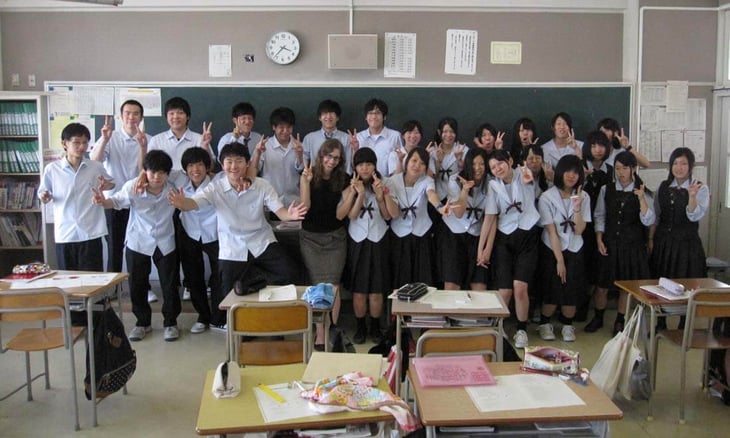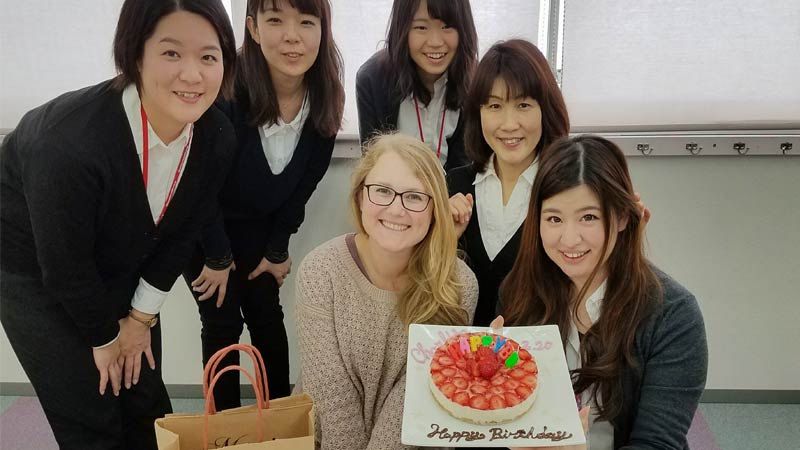What is the JET Program (Japan Exchange & Teaching Program)?
International TEFL Academy (ITA) advisor and JET Program alumna, Chelsea Hendrickx, draws upon her experience as an English teacher in Japan, and shares valuable insights on the Japan Exchange and Teaching Program (JET), including requirements, application process and FAQs.
Written By: Chelsea Hendrickx | Updated: December 18, 2023
Written By: Chelsea Hendrickx
Updated: December 18, 2023

Hey there! I'm Chelsea, a proud alumna of the Japan Exchange and Teaching (JET) Program, where I spent two incredible years teaching English in Japan. Join me as we dive into everything you need to know about this enriching program, one of the largest exchange programs in the world.
JET Program Japan Explained
Let's look at a comprehensive breakdown of the JET Program in Japan, uncovering its facets, requirements, and unique teaching opportunities.
JET Japan: Everything You Need to Know
What is The JET Program?
What is The JET Program for Teaching English in Japan?
The JET Program, or JET Programme, is a cultural exchange and teaching initiative sponsored by the Japanese government that employs university-educated, native English speakers to teach English in Japan. The acronym, JET, stands for Japan Exchange and Teaching.
Accepted participants are placed in positions throughout the country. While you can request preferences, your teaching location will ultimately be chosen for you.
Read more: Teach English in Japan
JET Program Snapshot
Here are a few key highlights of the JET Program:
- Applicants: University-educated native English speakers, including U.S. citizens
- Assigned Schools: Various schools across Japan, from elementary to high schools
- Length of Contract: Typically one year, with a maximum of five consecutive years
- Teaching Hours: Generally 35 hours per week, Monday to Friday
- Average Salary: Approximately ¥3,360,000/year ($2,675 USD) with yearly increases
- Application Period: Opens in October with a November deadline. Interviews start in January-February for a July departure
- Visa requirements: Participants must obtain an appropriate work visa for Japan
Please note that specific details and requirements may vary slightly each year, so it's crucial to refer to the official JET Program website for the most current and detailed information.
Now let's take a look at the qualifications you need to join the program:
The JET Program Japan Requirements
What are the Requirements for the JET Program?
To participate in the JET Program, you must meet the following requirements:
- Have a willingness to learn & adapt to Japanese culture
- Have a strong interest in Japan
- Be a U.S. Citizen by the date of application
- Have a Bachelor's Degree before the designated date of departure
- Have not participated in the JET program in the last 3 years or for a total of 5 years
- Have not previously declined a position with JET
- Have not lived in Japan for a total of 6 years in the past 10 years before departure
- Be interested in working with young learners
- Possess a TEFL/TESOL Certification (Highly recommended)
Read more: What Are The Basic Requirements To Teach English in Japan?
Owning a TEFL certification greatly improves a candidate's chances for acceptance due to the competitiveness of the program. Additionally, showing that you have or are currently studying and learning the Japanese language and the Japanese education system can prove useful.
The JET Program Application Process
Applying for the JET program is a lot like applying to a university or graduate school program. The JET application is completed via an online portal. Applications must be submitted during the fall period. The applicant will be expected to provide information on their academic background; Japanese language level & experience; Experience working or teaching children and young adults; And experience with living abroad.
Documents applicants can expect to submit for the JET Program will include:
- The Main Application Form
- A Self-Assessment Medical Form
- Official University Transcripts
- Degree or Proof of Expected Graduation
- A two-page double-spaced essay explaining motivation and qualifications to participate in JET
- Two letters of reference
- Proof of American Citizenship
JET is open to new applicants during the fall application period in October with a November application deadline. Interviews start in January-February for a July departure.
Please consult the JET Website for more details on the application & acceptance process.
"When I found out that I was accepted into the JET Programme for teaching English in Japan I was thrilled! Even without any Japanese experience, I had been accepted into one of the most widely acclaimed companies for teaching English in Japan."
Now that we looked into the requirements and application process, let's address a few more questions about this Japan exchange and teaching program:
Japan's JET Program FAQs
What is The JET Program Looking for?
The JET Program hires for three different positions with three different acronyms:
- ALT (Assistant Language Teacher): Assist Japanese teachers in English language education primarily in schools.
- CIR (Coordinator for International Relations): Facilitate international exchange and cooperation in local government offices or organizations.
- SEA (Sports Exchange Advisor): Promote sports-related activities and international exchange through sports in local communities.
90% of program participants are ALTs (Assistant Language Teachers). ALTs work in public schools in Japan as assistants to Japanese teachers of English (known within the Program as JTEs), though what this means in terms of teaching responsibility can vary widely from school to school.
Read further: What is the Difference Between Private and Public Schools in Japan?
How Long is The JET Program in Japan?
Every JET Program participant, regardless of location or level of students, will sign a one-year contract and can spend a maximum of 5 consecutive years on the JET Program. Participants typically work Monday - Friday, 35 hours a week as assistant English teachers, with 20 paid vacation days per year.
Participants may submit preferences for where they want to teach. Assignments are determined by JET and are given when acceptances into the program are announced.
How Much Does the JET Program Pay in Japan?
First-year JET Program participants receive an average yearly salary of ¥3,360,000, (approximately $2,675 per month) with yearly pay increases. This is enough to live comfortably in Japan.
Read more: How Much Do English Teachers Make in Japan?
Does JET Pay for Housing?
The housing under the JET Program may or may not be paid for or subsidized. However, roundtrip flights are provided for JET participants.
How Competitive is Japan's JET Program?
JET has a prestigious reputation and is, therefore, a bit more competitive than other teaching programs for teaching in Japan. Having an Internationally accredited TEFL Certification is a great way to boost your resume and validate teaching proficiency.
Read further: How Do I Get a Japan Work Visa For Teaching English?
Watch ITA graduate Heidi Perera discuss her experience teaching English in Japan with the JET Program:
Is a TEFL Certificate Required to Participate in Japan's JET Program?
A TEFL/TESOL certification is not technically required for the JET program. However, program applicants are encouraged to pursue the certification, as acceptance is becoming increasingly competitive. Holding a TEFL/TESOL certification shows that an applicant has invested in and studied the methodology behind teaching English as a foreign language. It is also useful to have gained practical teaching experience included in your TEFL/TESOL certification as a practicum (also known as hands-on live practice teaching). Expect your interview to contain many questions about teaching methodologies.
Some other factors to consider regarding the question of whether you should get a TEFL certification if you want to teach in the JET Program (or elsewhere):
- Your teaching experience will be far easier and more rewarding if you possess basic teaching skills in areas like classroom management, teaching methodology, and error correction. A primary complaint and reason for drop-outs in programs like JET is that participants without training feel lost and unable to cope with their classroom assignments because they are unprepared;
- Your students will learn more from you and respect you more (as will your colleagues and peers) if you are trained and possess professional-level teaching skills;
- A TEFL certification will provide you with the skills and qualifications to gain employment teaching English in up to 80 other countries worldwide and will qualify you for other teaching opportunities in Japan and elsewhere around the world.
What are My Health Insurance Options for the JET Program?
Jet Program Teachers will join the national social health insurance and will also be contributing to the pension fund program and paying employment insurance. A part of these costs is paid by the participant and deducted from monthly post-tax pay each month on payday. JET also pays for your initial flight to Japan as well as your flight back home when your contract finishes, which is a huge bonus!

Further Details from JET Program Alumna & International TEFL Academy (ITA) Admissions Advisor, Chelsea Hendrickx
Now that I've covered the general information about the JET Program, I'm also glad to share my own experience. Here are some useful tips and insights from my two years working in this program:
"The informal motto of the JET Program is, “every situation is different,” a phrase with which every participant is intimately acquainted (and truly is the informal motto of teaching abroad in general)."
- Chelsea Hendrickx, JET Program alumna
- An ALT may be assigned to one or multiple schools to serve as either a daily English teacher (this is the case for higher levels, such as in high schools) or a weekly or even monthly visiting teacher (more common in elementary schools).
- I worked as the ALT for two local high schools, one that was my “home school” where I worked Monday - Thursday, and another where I worked only on Fridays. I had friends who worked in 20+ elementary schools, friends who worked in a single high school school, and friends who worked in maybe 5-6 varied-level schools including preschools. Every situation is different;
- Depending on how your JTE wants to run their class (and you’ll work with many different JTEs), you will either be a true assistant teacher, helping with group activities and demonstrating natural, native English speaking, or you may run the whole show yourself as the lesson-planner and runner of the class while the JTE assists or observes;
- JET provides a great support system for its teachers, which is a big part of its draw. Each ALT is assigned a supervisor at their school who speaks English (they may be a JTE). The supervisor assists with every part of transitioning to a new country, including airport pick up, housing, cell phones, bank accounts, legal and even medical matters. Every ALT has housing set in advance, though whether this means a studio apartment or a two-story house, it's up to your local Board of Education and how they’ve set things up for their teachers. Many ALTs move into the apartment that a previous ALT occupied. Your school or Board of Education may even subsidize some or all of your rent, though it’s not required for them to do so;
- ALTs also receive a 3-day orientation in Tokyo where they can participate in a wide array of workshops with topics ranging from teaching to daily life in Japan to learning the Japanese language. There is a mid-year conference every year as well as the “Returner’s Conference” for when you are headed back home.
Teaching in Japan through the JET Program offers incredible cultural immersion and teaching experiences. Remember, every situation in the program is unique, so prepare thoroughly and embrace the journey. I hope you will enjoy it as much as I did!
Chelsea Hendrickx
Chelsea grew up in South Florida and attended the University of Florida. Following graduation, she hopped on a plane to teach English in Japan with the JET program for two years. Chelsea has worked as an Admissions Advisor at International TEFL Academy for more than 3 years and has assisted hundreds of ITA students in teaching English in Japan and around the world.
Want to Learn More About Teaching English Abroad & Online?
Request a free brochure or call 773-634-9900 to speak with an expert advisor about all aspects of TEFL certification and teaching English abroad or online, including the hiring process, salaries, visas, TEFL class options, job placement assistance and more.
"I chose ITA for two reasons. First, it offers a top online TEFL course option. Second, I found the ITA student experience stories really authentic and motivating. Hearing their experiences made me feel comforted."

- Alexandra Eilinsfeld
Teaches English in Japan







 "When I found out that I was accepted into the JET Programme for teaching English in Japan I was thrilled! Even without any Japanese experience, I had been accepted into one of the most widely acclaimed companies for teaching English in Japan."
"When I found out that I was accepted into the JET Programme for teaching English in Japan I was thrilled! Even without any Japanese experience, I had been accepted into one of the most widely acclaimed companies for teaching English in Japan."  "The informal motto of the JET Program is, “every situation is different,” a phrase with which every participant is intimately acquainted (and truly is the informal motto of teaching abroad in general)."
"The informal motto of the JET Program is, “every situation is different,” a phrase with which every participant is intimately acquainted (and truly is the informal motto of teaching abroad in general)."